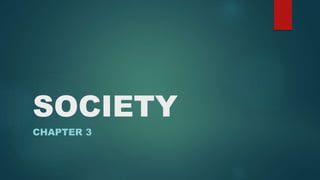
SOCIETY. presentation-1.pptx
- 2. Introduction: ‘Society is a concept used to describe the structured relations and institutions among a large community of people which cannot be reduced to a simple collection or aggregation of individuals.’
- 3. Elements of Society: Likeness: Likeness of members in a social group is the primary basis of their mutuality. May be in the beginning assumed or real common lineage, tribal affinity, family benefit or the compactness due to a common to time inculcated between and among the members in the group the feeling of likeness. Likeness means mutuality, and that means Society.
- 4. The Reciprocal Awareness: Likeness is generative of reciprocity. Once some are aware of the mutual likeness, they, certainly differentiate against those who are not like them. The problem of likes and dislikes was concomitant to the social growth. Consciousness of this kind, alone could make sense of likeness. All social action is based on reciprocal response. This alone, makes possible, the we-feeling.
- 5. Differences: Sense of likeness in not always sufficient. It alone is not adequate for social organisation. This does not exclude diversity or variation. The social structure of humanity is based on the family The culture of society prospers with the differences in thoughts ideals, viewpoints, etc. No two individuals are alike in their nature. They differ from each other in respect of their interests, capacities, abilities and tendencies etc. These differences do not imply mutual conflict; instead; by it the organisation of society is further strengthened. A 100 per cent organised society is not possible.
- 6. Interdependence: Society implies interdependence. It is another essential element to constitute society. It is not possible for human being to satisfy his desire in isolation. We cannot live alone. We needs the help of others for his survival. Society fulfills all the needs of the people.
- 7. Cooperation: Cooperation is also another essential element to constitute society. Without cooperation, no society can exist. If the members of the society do not work together for the common purposes, they cannot lead a happy and comfortable life.
- 8. Conflict: Conflict is an ever present phenomenon present in every human society. Not only cooperation but also conflict in necessary for the formation of society. They must coexist in a healthy society. Conflict is a process of struggle through which all things have come into existence.
- 9. The 5 main functions of society: Satisfaction of basic needs It is the primary function of society; organize people and their actions in such a way that they are guaranteed food, shelter and vital protection. Management of education Within society, individuals acquire the knowledge necessary to interact with their peers, in the first instance. But then, they are also trained to make the most of their abilities, talents and interests.
- 10. Division of labor: The organization in society also allows defining the roles in the work that each individual will fulfill given the needs to be met. Living in society makes clear this reality and guides people towards a distribution of the workforce that allows all tasks are fulfilled to provide well-being to individuals.
- 11. Leisure The fun of the members of a social group it is also something that must be considered, since the human being also requires moments of relaxation. Living in society facilitates the necessary infrastructure and technology so that people can take advantage of their free time as they prefer.
- 12. Communication management For the human being is inherent the need for expression and communication, so in society the conditions are created for this need to be fulfilled. This includes from language to communication channels (streets, bridges, etc.) between different members of the social group, as well as between these and other social groups.
- 13. Types of Societies: Hunting-and-Gathering Societies: These are small, simple societies in which people hunt and gather food. Because all people in these societies have few possessions, the societies are fairly egalitarian, and the degree of inequality is very low. Horticultural and pastoral: Horticultural and pastoral societies are larger than hunting- and-gathering societies. Horticultural societies grow crops with simple tools, while pastoral societies raise livestock.
- 14. Agricultural: These societies grow great numbers of crops, thanks to the use of plows, oxen, and other devices. Compared to horticultural and pastoral societies, they are wealthier and have a higher degree of conflict and of inequality. Industrial Industrial societies feature factories and machines. They are wealthier than agricultural societies and have a greater sense of individualism and a somewhat lower degree of inequality that still remains substantial.
- 15. Postindustrial These societies feature information technology and service jobs. Higher education is especially important in these societies for economic success.
- 17. Technology in Society: Technology involves the use of techniques, processes, and material objects to produce goods, provide services, and connect people. Sociologists study the social interactions that result Technology allows us to communicate instantly with people in our neighborhoods or around the globe. This innovation not only keeps us connected but can help us live safer and healthier lives. and how they are impacted by different technologies.
- 18. QUESTION & ANSWERS THANK YOU.